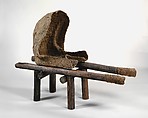Androgyne III
Magdalena Abakanowicz Polish
Not on view
In the 1960s, the Polish artist Magdalena Abakanowicz received international acclaim for her large and imaginative abstract woven hangings made of various ropes and fibers. She began to make freestanding sculptures in the early 1970s from similar materials, particularly burlap, string, and cotton gauze. Her work since 1974 has featured fragmented human figures—faces without skulls, bodies without heads, and torsos without legs—placed singly or in large groupings. These body parts appear as hollow shells, the result of their being hardened fiber casts made from plaster molds. Yet despite their incompleteness, they are intended to be seen in the round, the hollow interior being as much a part of the piece as the molded exterior. The creases, ridges, and veins of the hardened-fiber surface assume organic characteristics, reminiscent of the earth's rough surface or the cellular composition of human skin.
Androgyne III of 1985 utilizes the same molded-torso shell that Abakanowicz used in her sculpture series Backs, begun in 1976. Unlike the earlier pieces, however, which sat directly on the floor, the Androgyn torsos are perched on low stretchers of wooden logs, the long poles filling in for lost legs. Through these provocative images, the artist expresses the physical and spiritual condition of mankind. As she says, they are "about existence in general."
Due to rights restrictions, this image cannot be enlarged, viewed at full screen, or downloaded.
This artwork is meant to be viewed from right to left. Scroll left to view more.



